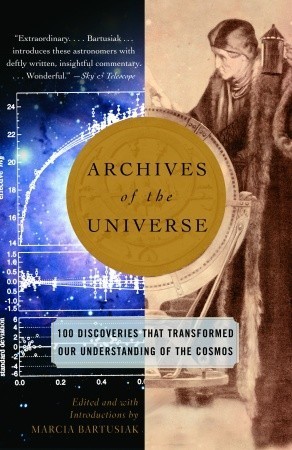What do you think?
Rate this book


720 pages, Paperback
First published November 23, 2004
To accomplish this immense task, Pickering hired a corps of women, called "computers," who were trained to swiftly and accurately categorize the spectra. Annie Jump Cannon, who studied physics and astronomy in college, signed on in 1896 and ultimately established the stellar classification scheme still used today.
Along the way (in collaboration with his wife and observational partner, Margaret), Huggins detected a number of spectral lines that he could not identify, which he boldly suggested might indicate the presence of matter not yet recognized by earthbound chemists.
From this and other research, he concluded that the dark lines discovered by Fraunhofer were generated as each element in the Sun's cooler outer atmosphere absorbed specific wavelengths from the Sun's hot inner glow. The dark lines, consequently, came to be called "absorption lines."
Orphaned as a young boy, Fraunhofer was apprenticed to a tyrannical looking-glass manufacturer, who overworked and underfed the frail lad. Fraunhofer was liberated in 1801 at the age of fourteen when his slum tenement house collapsed and he was rescued from the wreckage as the sole survivor. Given a large sum of money from a sympathetic government official, the gifted teenager was able to pursue optics on his own. Becoming a master optician within a decade, Fraunhofer began studying prisms in the hope of getting rid of the rainbow effect in lenses, their tendency to produce fringes of color in an image. In the course of this investigation, he constructed the first spectroscope - a small telescope focused on a narrow slit, through which sunlight entered and passed through a prism. To his surprise, when he looked through the telescopic eyepiece, he saw hundreds of lines, both strong and weak, in the solar spectrum [...]
In his report to the Philosophical Transactions (the first major scientific discovery announced in a journal rather than a book), Newton dubbed the multicolored display a spectrum, Latin for "apparition" or "spector."
Plate holders and spectrographs became standard equipment at observatories, changing an astronomer's lifestyle. No longer restricted to nighttime hours, astronomers could carefully examine images and spectra at their leisure, with timed exposures extending the limitations of their eyes alone.
Mirrors were originally constructed of metal, which was hard to shape. But once a method was developed to deposit silver on glass, the sizes of reflectors grew rapidly, reaching 100 inches at the Mount Wilson Observatory in California by 1917.
Not until 1916 in the United States did the two camps fuse, when the original Astronomical and Astrophysical Society of America became simply the American Astronomical Society.
Spectroscopy was at first called the "new astronomy" and later "astrophysics." It was a technique initially adopted by wealthy amateurs or supported by private means, because traditional astronomers were resistant to the newcomer.
Stars seemed so inaccessible to direct study that Auguste Comte, the French philosopher of positivism, which stressed that true science must be based on experience, concluded around 1835 that humanity would be forever barred from discerning the chemical and physical makeup of celestial bodies.
Kant's book on cosmology was virtually ignored until, years later, he achieved considerable fame as one of the great Western philosophers. But it would take much longer for his island universe model to be widely accepted. Given the quality of astronomical observations in the 1700s, those enigmatic spots could just as easily have been celestial clouds caught at the borders of the Milky Way's disk.
A name for the new planet became a cause célèbre. Among the suggested choices were Hypercronius ("above Saturn"), Cybele (the wife of Saturn), Minerva (the Roman goddess of wisdom), and even Herschel (extending the tradition of naming comets after their discoverers to planets). Herschel himself preferred Georgium Sidus ("the Georgian star") in honor of England's King George III, a fellow Hanoverian. Uranus, a suggestion by the Berlin astronomer Johann Bode and the choice of astronomers outside England, eventually won out.
In casual conversations with acquaintances, Newton claimed that the seeds of his major achievements - the theory of colors, the calculus, and the law of gravity - were planted in the years 1665 and 1666, when he "was in the prime of my age for invention, and minded mathematics and philosophy more than at any time since." He had temporarily left his undergraduate studies at Cambridge University and returned to his childhood home in the rural hamlet of Woolsthorpe to wait out a plague epidemic.
Islamic religious requirements (sighting the new Moon to begin a new month, timing the start of prayers throughout the day, properly orienting mosques toward Mecca) led to advances in celestial and terrestrial mapping. Observatories were built and instruments such as sextants and astrolabes improved for determining more precise positions of celestial bodies (oftentimes funded by rich patrons interested in astrological forecasts). The notable Islamic influence on astronomy is preserved in the names of many stars, such as Aldebaran, Altair, and Betelgeuse, as well as the astronomical terms zenith and nadir.
Books VII and VIII deal with the fixed stars and include his catalog of some one thousand stars and forty-eight constellations. This catalog would not be surpassed until the fifteenth century with the work of Ulugh Beg at his great observatory in central Asia and of Tycho Brahe a hundred years later.
Born around 276 B.C. in Cyrene, a Greek town on the North African coast in what is now Libya, Eratosthenes studied in Athens and became the tutor to a pharaoh of Egypt. He rose to become head of the great library in Alexandria. Eclectic in his interests, he was nicknamed "Beta" for his failure to be preeminent in any one field. He was a literary scholar, philosopher, and mathematician, as well as a specialist in geography.